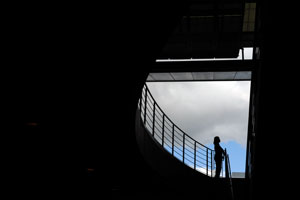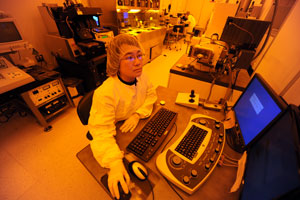Graphene explorer
Physicist Jeanie Lau paves the way to developing a faster, more energy-efficient computer chip.
By Stuart Fox, AB’04
Photography by Dan Dry
When Chun Ning “Jeanie” Lau, AB’94, a physicist at the University of California, Riverside, began studying graphene, she knew virtually nothing about the carbon compound. But then again, no one did.

“The less you understand” at first, “the better,” Lau says of her research.
“My style of research is kind of the Christopher Columbus approach,” says Lau, an associate professor of condensed-matter physics. “The less you understand, the better, because there’s more to discover and explore.”
Her exploratory approach has served Lau well, earning her grants, national awards—including a January 2010 Presidential Early Career Award for Scientists and Engineers—and a deeper understanding of the physics of carbon compounds. In the nearly four years she’s been studying graphene, Lau has made discoveries about both its electrical conductivity and how to form it into shapes useful for producing computer chips.
Graphene—first experimentally isolated in October 2004 by a team of physicists at the University of Manchester and Russia’s Institute for Microelectronics Technology—is a honeycomb-shaped sheet of carbon particles only one atom thick. Despite its simple arrangement, it displays a unique suite of properties. A sheet of graphene can stretch like rubber yet withstand 200 times the stress of steel, making it one of strongest materials ever created. It can conduct electricity with almost no resistance, making it a better material for computer chips than silicon.
When graphene was first isolated, Lau had been studying carbon nanotubes—which exhibit properties similar to graphene and are easier to produce—since her Harvard graduate studies. But despite the similarities, Lau didn’t switch her focus until 2006, when one of her UC Riverside students convinced her that graphene, easier than nanotubes to manipulate, held more potential for discovery.
“I have to thank my graduate student at the time,” says Lau. “I gave him a choice between doing graphene or nanotubes, and he said, ‘Hey, new system, we don’t really know what’s going to happen; let’s do it.’ He had good taste, and I had good taste for listening to him.”

Lau’s work on graphene and its electrical properties may have engineering applications.
Within a year Lau and her team made key discoveries about graphene’s electrical properties. She showed that electrons moving across a graphene sheet act as quantum mechanical waves, not as classical mechanical particles, as they do in silicon. Because the quantum mechanical electrons move more easily than the particle-like electrons, this discovery—which helped earn Lau the 2008 National Science Foundation Early Career Development Award—suggested that graphene might produce computer chips faster, smaller, and more energy efficient than current silicon chips.
Since August 2008 Lau has investigated a phenomenon that could help build such a chip. Research had already shown that graphene sheets wrinkle when stretched, and those wrinkles form barriers that separate electrons, potentially creating a transistor on a graphene chip just like those on a silicon computer chip. By explaining how wrinkles form on graphene, Lau and her team have formed a foundation for crafting wrinkles in deliberate ways, opening a new direction for manufacturing computer chips.
“How well graphene conducts electricity depends on the shape,” says Lau. “If you can change the shape in just the right way, maybe you can create all different kinds of electronics. It’s a whole new way of creating devices.”
Per her modus operandi, Lau is unsure where her research will take her next, though it likely will involve graphene.
“I guess I don’t have a very good plan,” she says. “I am more interested in fundamental physics, not answering a multibillion-dollar question. I usually just start doing things, and my research tells me where to go.”
WRITE THE EDITOR
E-MAIL THIS ARTICLE
SHARE THIS ARTICLE
RELATED LINK
Jeanie Lau’s UC Riverside page
